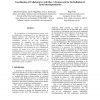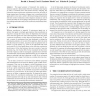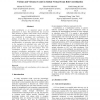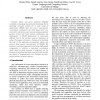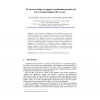130
click to vote
AAMAS
2004
Springer
15 years 19 days ago
2004
Springer
This paper presents and evaluates a decision making framework that enables autonomous agents to dynamically select the mechanism they employ in order to coordinate their inter-rela...
CRIWG
2001
15 years 2 months ago
2001
The coordination of interdependencies between tasks in collaborative environments is a very important and difficult endeavor. The separation between tasks and interdependencies al...
109
Voted
STAIRS
2008
15 years 2 months ago
2008
Abstract. Physical agents such as robots are generally constrained in their communication capabilities. In a multi-agent system composed of physical agents, these constraints have ...
107
Voted
ICWS
2008
IEEE
15 years 2 months ago
2008
IEEE
A current trend in the web services community is to define coordination mechanisms to execute collaborative tasks involving multiple organizations. Following this tendency, this w...
103
click to vote
CRIWG
2007
15 years 2 months ago
2007
Abstract. This paper presents Relations Graph – GR a methodology to automate the generation of coordination mechanisms in computational environments. GR explores encapsulation an...
109
Voted
CLIMA
2007
15 years 2 months ago
2007
Abstract. Task-based planning problems for multi-agent systems require multiple agents to find a joint plan for a constrained set of tasks. Typically, each agent receives a subset...
ECAI
2000
Springer
15 years 5 months ago
2000
Springer
Abstract. This paper presents a framework that enables autonomous agents to dynamically select the mechanism they employ in order to coordinate their inter-related activities. Adop...
104
click to vote
HICSS
2005
IEEE
15 years 6 months ago
2005
IEEE
Role coordination is an important aspect of task performance in teams. This phenomenon has received little attention in global virtual teams (GVT) with their coordination hurdles....
107
click to vote
ETFA
2006
IEEE
15 years 6 months ago
2006
IEEE
Wireless Sensor and Actor Networks (WSANs) constitute an emerging and pervasive technology that is attracting increased interest for a wide range of applications. WSANs have two m...
101
Voted
CDVE
2007
Springer
15 years 7 months ago
2007
Springer
In the Architecture Engineering and Construction sector (AEC) cooperation between actors is essential for project success. The configuration of actors’ organization takes differe...

